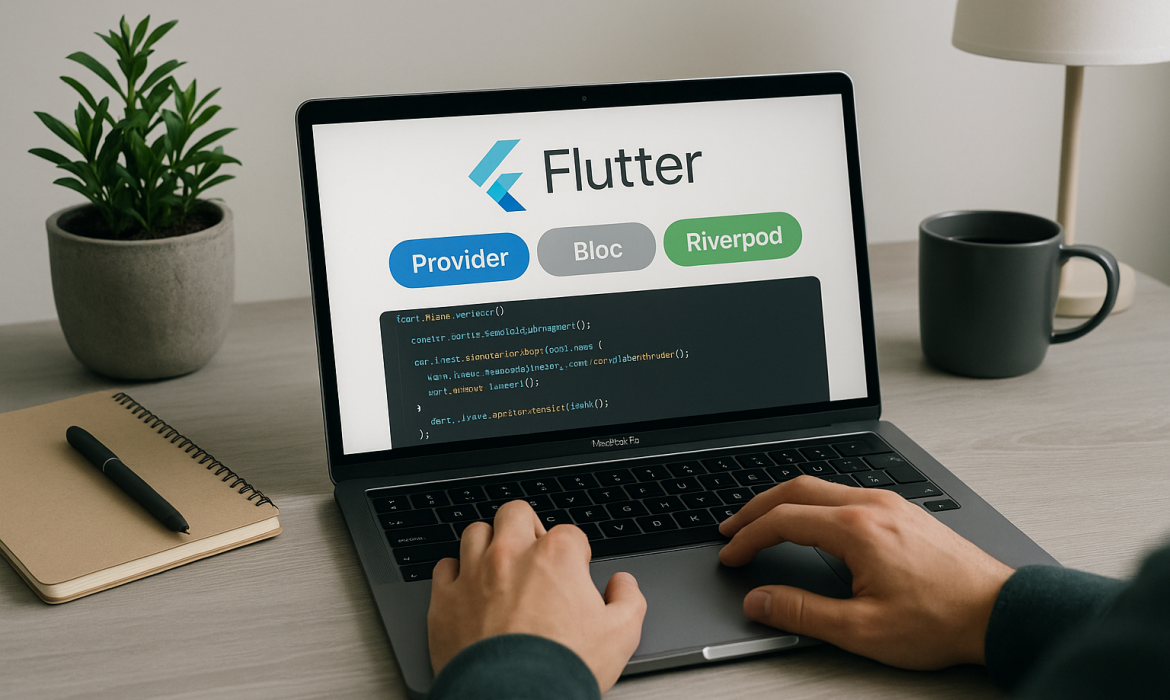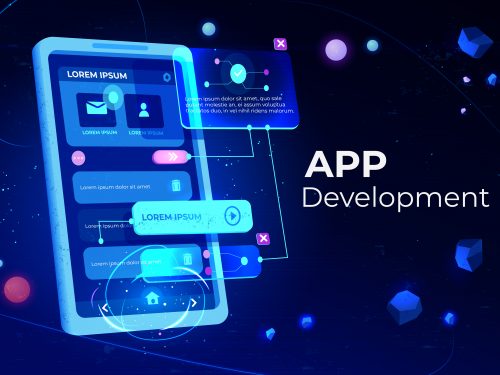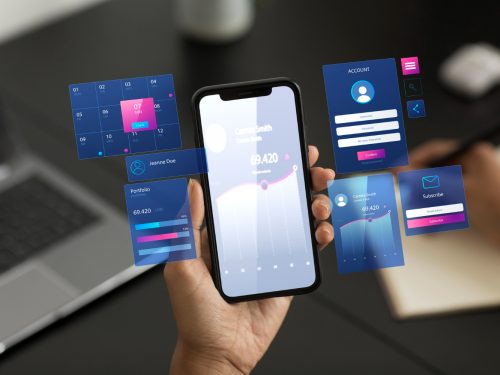State management is the backbone of any successful Flutter application. As your app grows in complexity, managing data flow between widgets becomes increasingly challenging. Without proper state management, you’ll find yourself wrestling with widget rebuilds, performance issues, and code that’s difficult to maintain and test.
Flutter offers several powerful state management solutions, each with its own strengths and use cases. In this comprehensive guide, we’ll explore three of the most popular approaches: Provider, Bloc, and Riverpod. By the end of this article, you’ll understand when to use each solution and how to implement them effectively in your Flutter projects.
Understanding State in Flutter Applications
Before diving into specific solutions, it’s crucial to understand what state means in Flutter context. State represents any data that can change during the lifetime of your application – user preferences, API responses, form inputs, navigation state, and more.
Flutter widgets are immutable, meaning they cannot change once created. When state changes, Flutter creates new widget instances to reflect these changes. This approach ensures predictable UI updates but requires careful consideration of how and where state is managed.
State can be categorized into two main types: local state and global state. Local state affects only a single widget or a small widget subtree, while global state impacts multiple widgets across different parts of your application. Effective state management solutions help you handle both types efficiently.
Provider: The Foundation of Flutter State Management
Provider is one of the most widely adopted state management solutions in the Flutter ecosystem. Built on top of InheritedWidget, Provider offers a simple yet powerful way to manage state across your application.
Core Concepts of Provider
Provider works on the principle of dependency injection, allowing you to provide objects to widget trees and consume them wherever needed. The main components include ChangeNotifier for state objects, Provider widgets for dependency injection, and Consumer widgets for listening to state changes.
ChangeNotifier is a simple class that provides change notification to its listeners. When you extend ChangeNotifier, you gain access to notifyListeners() method, which triggers rebuilds in widgets that depend on this state.
Implementing Provider in Your Flutter App
To get started with Provider, add the provider package to your pubspec.yaml file. Create a class that extends ChangeNotifier to hold your application state:
class CounterProvider extends ChangeNotifier {
int _count = 0;
int get count => _count;
void increment() {
_count++;
notifyListeners();
}
void decrement() {
_count–;
notifyListeners();
}
}
Wrap your app with ChangeNotifierProvider to make the state available throughout your widget tree:
MultiProvider(
providers: [
ChangeNotifierProvider(create: (_) => CounterProvider()),
ChangeNotifierProvider(create: (_) => UserProvider()),
],
child: MyApp(),
)
Consume the state in your widgets using Consumer or Provider.of():
Consumer<CounterProvider>(
builder: (context, counter, child) {
return Text(‘Count: ${counter.count}’);
},
)
Provider Advantages and Use Cases
Provider excels in scenarios where you need straightforward state management without complex business logic. It’s perfect for simple applications, prototyping, and when you want minimal boilerplate code. The learning curve is gentle, making it ideal for developers new to state management concepts.
Provider integrates seamlessly with Flutter’s widget system and provides excellent performance through selective rebuilds. Its widespread adoption means extensive community support and numerous learning resources.
Bloc Pattern: Separating Business Logic from UI
Bloc (Business Logic Component) is a more sophisticated state management solution that enforces separation of concerns by isolating business logic from presentation layers. Developed by Google developers, Bloc follows reactive programming principles using Streams.
Understanding Bloc Architecture
Bloc pattern consists of three main components: Events (user interactions or system events), States (representations of application state), and the Bloc itself (processes events and emits states). This architecture promotes testability, reusability, and maintainability.
Events are inputs to the Bloc, representing user actions like button presses or API calls. States are outputs from the Bloc, representing different conditions of your application. The Bloc acts as a converter, taking events as input and producing states as output.
Setting Up Bloc in Flutter
Add the flutter_bloc package to your dependencies. Create events that represent user interactions:
abstract class CounterEvent {}
class CounterIncremented extends CounterEvent {}
class CounterDecremented extends CounterEvent {}
Define states that represent different conditions:
abstract class CounterState {}
class CounterInitial extends CounterState {}
class CounterValue extends CounterState {
final int value;
CounterValue(this.value);
}
Implement the Bloc class:
class CounterBloc extends Bloc<CounterEvent, CounterState> {
CounterBloc() : super(CounterInitial()) {
on<CounterIncremented>((event, emit) {
if (state is CounterValue) {
emit(CounterValue((state as CounterValue).value + 1));
} else {
emit(CounterValue(1));
}
});
on<CounterDecremented>((event, emit) {
if (state is CounterValue) {
emit(CounterValue((state as CounterValue).value – 1));
} else {
emit(CounterValue(-1));
}
});
}
}
Integrating Bloc with Flutter Widgets
Use BlocProvider to provide the Bloc to your widget tree:
BlocProvider(
create: (context) => CounterBloc(),
child: CounterPage(),
)
Listen to state changes with BlocBuilder:
BlocBuilder<CounterBloc, CounterState>(
builder: (context, state) {
if (state is CounterValue) {
return Text(‘Count: ${state.value}’);
}
return Text(‘Count: 0’);
},
)
Dispatch events using BlocProvider.of() or context.read():
context.read<CounterBloc>().add(CounterIncremented());
When to Choose Bloc
Bloc shines in complex applications with intricate business logic, multiple data sources, and requirements for high testability. It’s particularly valuable in enterprise applications where code maintainability and team collaboration are priorities.
The pattern enforces good architecture practices and makes testing straightforward since business logic is completely separated from UI components. However, it requires more boilerplate code compared to simpler solutions.
Riverpod: The Evolution of Provider
Riverpod represents the next generation of state management for Flutter, addressing limitations of Provider while maintaining its simplicity. Created by the same developer who built Provider, Riverpod offers compile-time safety, better testability, and more flexible dependency injection.
Key Features of Riverpod
Riverpod eliminates the need for BuildContext when reading providers, reducing coupling between state and widgets. It provides compile-time safety, catching errors during development rather than runtime. The solution supports provider scoping, allowing you to override providers for specific widget subtrees.
Riverpod offers multiple provider types for different use cases: Provider for immutable values, StateProvider for simple mutable state, StateNotifierProvider for complex state management, and FutureProvider for asynchronous operations.
Implementing Riverpod
Add flutter_riverpod to your dependencies and wrap your app with ProviderScope:
void main() {
runApp(
ProviderScope(
child: MyApp(),
),
);
}
Create providers outside of widgets:
final counterProvider = StateProvider<int>((ref) => 0);
final userProvider = StateNotifierProvider<UserNotifier, User>((ref) {
return UserNotifier();
});
For complex state, extend StateNotifier:
class UserNotifier extends StateNotifier<User> {
UserNotifier() : super(User.initial());
void updateName(String name) {
state = state.copyWith(name: name);
}
void updateEmail(String email) {
state = state.copyWith(email: email);
}
}
Consuming Riverpod Providers
Use ConsumerWidget instead of StatelessWidget to access providers:
class CounterWidget extends ConsumerWidget {
@override
Widget build(BuildContext context, WidgetRef ref) {
final count = ref.watch(counterProvider);
return Column(
children: [
Text(‘Count: $count’),
ElevatedButton(
onPressed: () => ref.read(counterProvider.notifier).state++,
child: Text(‘Increment’),
),
],
);
}
}
For StatefulWidget, use ConsumerStatefulWidget:
class CounterPage extends ConsumerStatefulWidget {
@override
_CounterPageState createState() => _CounterPageState();
}
class _CounterPageState extends ConsumerState<CounterPage> {
@override
Widget build(BuildContext context) {
final count = ref.watch(counterProvider);
return Scaffold(
body: Center(child: Text(‘Count: $count’)),
);
}
}
Advanced Riverpod Features
Riverpod supports provider combinations and dependencies. You can create providers that depend on other providers:
final filteredTodosProvider = Provider<List<Todo>>((ref) {
final todos = ref.watch(todosProvider);
final filter = ref.watch(todoFilterProvider);
return todos.where((todo) => filter.apply(todo)).toList();
});
Family modifiers allow creating providers with parameters:
final todoProvider = Provider.family<Todo, String>((ref, id) {
return ref.watch(todosProvider).firstWhere((todo) => todo.id == id);
});
Riverpod vs Provider: Making the Choice
Riverpod offers several advantages over Provider: compile-time safety, better testability, no BuildContext dependency, and more flexible provider composition. However, Provider has a larger ecosystem and more learning resources due to its longer presence in the Flutter community.
Choose Riverpod for new projects where you want modern features and improved developer experience. Provider remains a solid choice for existing projects or when working with teams familiar with its patterns.
Choosing the Right State Management Solution
The choice between Provider, Bloc, and Riverpod depends on your project requirements, team expertise, and long-term maintenance considerations.
Project Complexity Considerations
For simple applications with minimal state management needs, Provider offers the quickest path to implementation. Medium complexity projects benefit from Provider’s balance of simplicity and power. Complex enterprise applications with intricate business logic are best served by Bloc’s architectural patterns.
Team and Maintainability Factors
Consider your team’s experience level and the project’s expected lifespan. Provider has the gentlest learning curve, making it suitable for junior developers or tight deadlines. Bloc requires more upfront investment in learning but pays dividends in large, long-lived projects. Riverpod offers modern features that improve developer experience once the initial learning curve is overcome.
Performance Characteristics
All three solutions offer excellent performance when implemented correctly. Provider and Riverpod provide fine-grained control over widget rebuilds. Bloc’s stream-based architecture naturally debounces rapid state changes. The performance difference is negligible in most real-world applications.
Best Practices and Common Pitfalls
Regardless of your chosen solution, certain best practices apply universally. Keep state classes immutable when possible, minimize the scope of state providers, and separate business logic from UI components.
Common mistakes include creating too many small providers, not properly disposing of resources, and mixing different state management approaches within the same application. Consistency in approach leads to more maintainable codebases.
Testing strategies vary by solution but generally involve mocking providers or blocs and verifying state changes. Provider and Riverpod offer excellent testability through dependency injection, while Bloc’s separation of concerns makes unit testing straightforward.
Migration Strategies and Coexistence
You don’t need to choose one solution exclusively. Different parts of your application can use different state management approaches based on their specific needs. However, mixing approaches requires careful consideration to avoid confusion and maintain code consistency.
When migrating between solutions, start with new features or isolated components. Gradual migration reduces risk and allows your team to become familiar with the new approach before committing fully.
Conclusion
State management is a critical aspect of Flutter development that significantly impacts your application’s maintainability, testability, and user experience. When considering how much does it cost to build an app with Flutter in 2025, it’s important to factor in the state management solution you choose. Provider, Bloc, and Riverpod each offer unique advantages suited to different scenarios, which can influence both development time and overall costs.
Provider remains an excellent choice for developers seeking simplicity and quick implementation, often resulting in lower initial development costs. Bloc provides robust architecture for complex applications requiring strict separation of concerns, which might slightly increase upfront costs but pays off in maintainability. Riverpod represents the future of Flutter state management with modern features and improved developer experience, potentially offering a balanced cost-to-benefit ratio in 2025 projects.
The key to successful state management lies not just in choosing the right tool, but in understanding your application’s requirements and implementing consistent patterns throughout your codebase. Start with the solution that matches your current needs and expertise level, and don’t hesitate to evolve your approach as your application and team grow.
Remember that the best state management solution is the one that your team can implement effectively and maintain consistently. Focus on creating clean, testable code that serves your users’ needs, and let the technical choices support that primary goal.
Frequently Asked Questions
Q1: Which state management solution is best for Flutter beginners?
Provider is the most beginner-friendly option due to its simple API and gentle learning curve. It integrates seamlessly with Flutter’s widget system and has extensive documentation and community support for new developers.
Q2: Can I use multiple state management solutions in the same Flutter project?
Yes, you can mix different state management approaches within the same project. However, maintain consistency within feature modules and clearly document your architectural decisions to avoid confusion among team members.
Q3: How does Riverpod improve upon Provider’s limitations?
Riverpod offers compile-time safety, eliminates BuildContext dependency, provides better testability, supports provider scoping, and includes advanced features like family modifiers and provider combinations that weren’t available in Provider.
Q4: When should I choose Bloc over simpler state management solutions?
Choose Bloc for complex applications with intricate business logic, multiple data sources, strict testing requirements, or when working in large teams where architectural consistency and separation of concerns are crucial.
Q5: What are the performance differences between Provider, Bloc, and Riverpod?
All three solutions offer excellent performance when implemented correctly. The differences are negligible in most applications. Focus on proper implementation patterns like selective rebuilds and appropriate provider scoping rather than theoretical performance comparisons.






